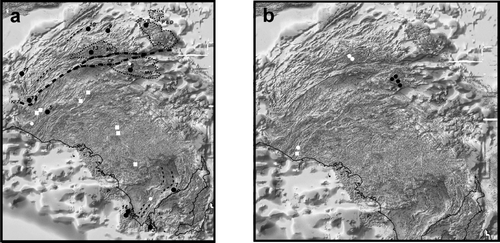Figures & data
Figure 1 Current distribution of tectonic elements of Proterozoic Australia that formed prior to ca 1070 Ma. Constructed from GIS datasets of Northern Territory Geological Survey, Geological Survey of Western Australia, Primary Industries and Resources South Australia, Geological Survey of Queensland. Australian coast outline adapted from topographic dataset of Geoscience Australia. Gawler Craton outline and detail interpreted from geophysical datasets (Fairclough et al. Citation2003).
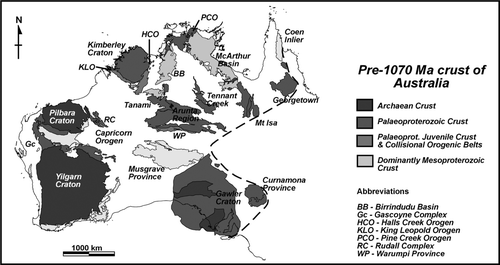
Figure 2 Simplified solid geology of the Gawler Craton (after Fairclough et al. Citation2003). Inset, Total Magnetic Intensity image of the Gawler Craton overlain by interpreted domains with selected domain names: P & D, Peake and Denison Domain; CP, Coober Pedy Domain; MW, Mt Woods Domain.
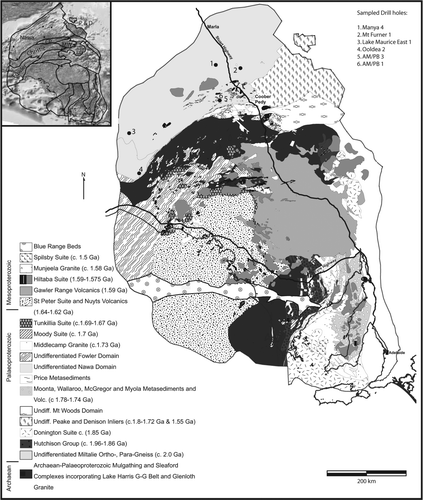
Figure 3 Total Magnetic Intensity image of the Gawler Craton overlain with distribution of Kimban Orogeny metamorphic and magmatic ages on the Gawler Craton. Dashed lines represent interpreted domains with the Coober Pedy Domain (CP), Mabel Creek Ridge (MC), Peake and Denison Domain (P & D) and Mt Woods Domain (MW) and trace of the Karari Fault Zone (KFZ, bold line) marked. Metamorphic ages (black dots) are: 1, 1731 ± 8 Ma (U–Pb SHRIMP zircon: Vassallo 2001); 2, 1699 ± 15 Ma (MSWD 7.3, U–Pb SHRIMP zircon: Vassallo 2001); 3, 1693 ± 9 (MSWD 8.5, U–Pb SHRIMP zircon: Vassallo 2001); 4, 1701 ± 2.8 Ma (U–Pb zircon: Vassallo 2001); 5, 1712 ± 10 Ma (U–Pb SHRIMP monazite: Teasdale 1997); 6, 1736 ± 14 Ma (U–Pb SHRIMP zircon Daly et al. 1998); 7, 1696 ± 12 Ma (U–Pb SHRIMP zircon, 4 analyses: Daly et al. 1998); 8, 1728 ± 30 Ma (Pb–Pb garnet: Hopper 2001); 9–13, Kimban Orogeny metamorphic ages from this study; 14, 1728 ± 13 Ma (U–Pb SHRIMP monazite: Dutch et al. 2006); 15, 1720 ± 6 Ma (U–Pb SHRIMP monazite: Dutch et al. 2006). White dots represent the location of dated syn-orogenic Kimban granites; white squares represent the location of dated post-orogenic Tunkillia Suite granites: granite data from Teasdale (1997), Daly et al. (1998) and Ferris (2001).
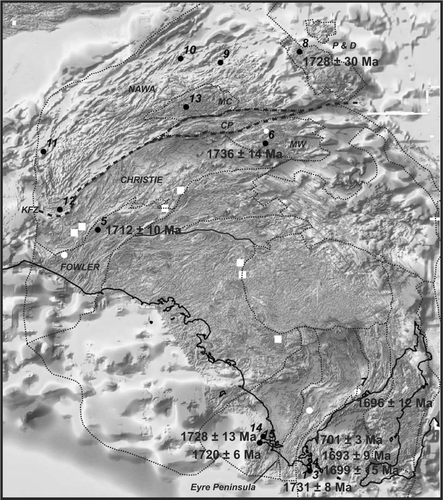
Table 1 Sample descriptions and drillhole locations.
Figure 4 Metamorphic mineral assemblages. (a) Mt Furner 1, showing sillimanite inclusions in garnet and late coarse-grained muscovite growth. (b) Manya 4, garnet, biotite and quartz with weathering products. (c) Lake Maurice East 1, garnet, magnetite, sillimanite with quartz ribbons. Alteration products are pseudomorphing plagioclase and cordierite. (d) Lake Maurice East 1, garnet and magnetite symplectite textures. (e) Ooldea 2, garnet and magnetite symplectite. (f) Enhanced photograph of Ooldea 2 drillcore demonstrating UHT fine-grained mylonitic fabric (taken from Teasdale 1997). (g) AM/PB 3, breakdown texture of garnet to orthopyroxene. (h) AM/PB 3, fine-grained shear fabric overprinting primary coarse-grained fabric. (i) AM/PB 1, coarse-grained garnet showing sillimanite inclusions paralleling the curved foliation enclosing the garnet in the matrix. (j) AM/PB 1, coarse-grained cordierite enclosed by quartz and sillimanite. bi, biotite; gt, garnet; mag, magnetite; mus, muscovite; opx, orthopyroxene; plg, plagioclase; qtz, quartz; sill, sillimanite; cd, cordierite; (cd), clay minerals after cordierite; (plg), clay minerals after plagioclase; wth, indeterminate weathering products.
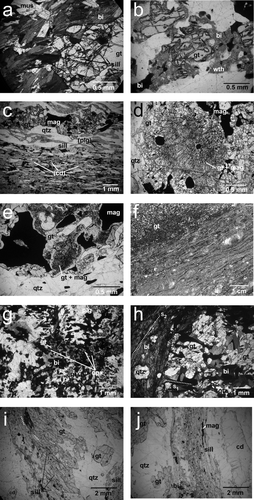
Figure 5 BSE images of representative monazites from each sample analysed. (a) Mt Furner 1. (b) Manya 4. (c) Lake Maurice East 1: gr 1, resorption textures; gr 2, concentric zoning. (d) Lake Maurice East 1, resorption textures (e) Ooldea 2. (f) AM/PB 3, monazite with ca 1555 Ma rim. (g) AM/PB 3, monazite with inconsistent BSE zoning and ages. (h) AM/PB 1, monazite from garnet separate with two growth zones evident, highlighted by dashed white line.
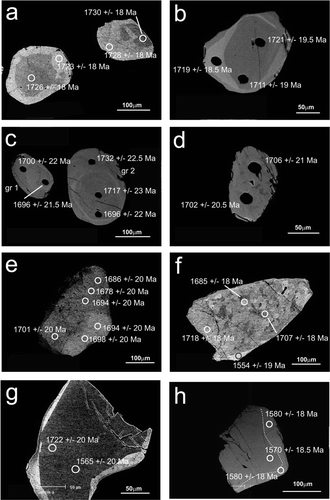
Figure 6 Concordia, weighted average and probability density plots for all data from analysed samples. (a, b) Mt Furner: (a) concordia; (b) 207Pb/206Pb weighted average. (c, d) Manya 4: (c) concordia; (d) 207Pb/206Pb weighted average. (e, f) Lake Maurice East: (e) concordia; (f) 207Pb/206Pb weighted average. (g, h) Ooldea 2: (g) concordia; (h) 207Pb/206Pb weighted average. (i–k) AM/PB3: (i) concordia, all data; (j) 207Pb/206Pb weighted average, old group; (k) 207Pb/206Pb weighted average, young group. (l–n) AM/PB1: (l) concordia bulk-rock monazites and garnet-separate monazites (grey ellipses); (m) 207Pb/206Pb weighted average, garnet-separate monazites; (n) 207Pb/206Pb weighted average, bulk-rock monazites excluding monazite grain displaying two simple growth zones in BSE imaging; 207Pb/206Pb weighted average for all analyses is 1569 ± 8 Ma.
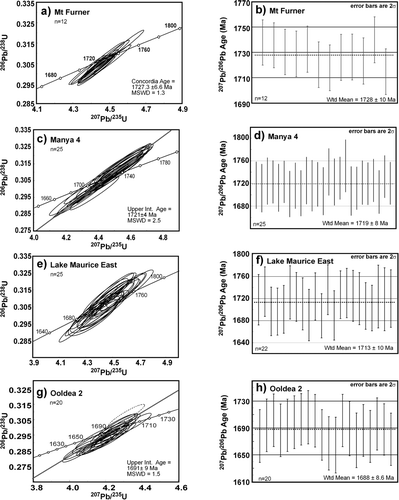
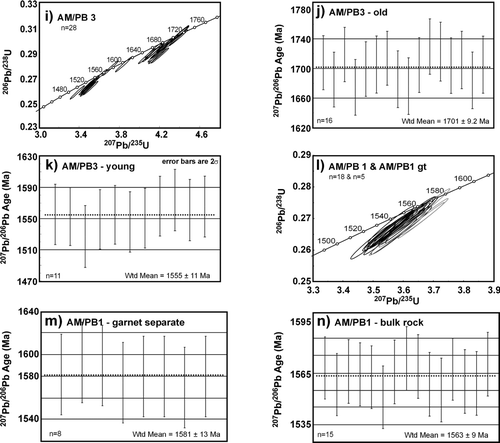
Table 2 Summary of orogenic events in the Gawler Craton.
Figure 7 (a) TMI data of the Gawler Craton overlain with locations of Kimban Orogeny metamorphic age data. Black dots represent metamorphic ages; white dots and squares represent syn- and post-Kimban magmatism. Dashed trendlines represent structural trends interpreted to have formed during the Kimban Orogeny. (b) TMI data of Gawler Craton overlain with location and ages of metamorphic mineral geochronology in the ca 1585–1545 Ma interval. Black dots represent U–Pb metamorphic ages in the interval 1590–1570 Ma; White dots represent U–Pb metamorphic ages in the 1570–1550 Ma interval; the white square represents metamorphic age in the 1550–1540 Ma interval. See text for data sources.
